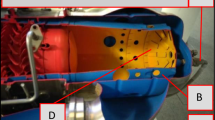Abstract
The global concern over climate change reflected in the Paris Agreement has emphasized the need to accelerate carbon emissions reductions. Nitrogen oxide emissions is another area of concern. Efforts in using renewable biofuels and lower carbon gaseous fuels have not succeeded yet, due to biofuel’s currently higher prices, in contrary to hydrocarbon fuels, and the structural/size challenges of pressurized fuel gas tanks. Therefore, a compromise is proposed, by combusting Kerosene Jet A fuel with a small fraction of superheated steam injection. Practically, making the smaller superheated steam tanks covers longer distances in larger aircraft. The results have shown the following reductions based on injecting a 0.1 mass fraction of superheated; unburned fuel from 10.4 to 2.5 ppm, combustion temperature from 674.5 to 626.7 °C, soot from 33.6 to 7.91 ppm, NOx from 84 to 42.9 ppm, and CO2 from < 36,206 to < 32,323 ppm. However, this temperature drop has caused a small reduction on the engine work output (T3 − T4). Validated results have shown that accuracies can be in the region 2.1 and 5.9% for pressure and NOx, respectively. Other validated results are within range and depend on the quality of the fuel supply.








Similar content being viewed by others
References
RR 250 C20B Training Manual, Rolls Royce Customer training Department, RR Corporation Indianapolis USA. Sections; Basic engine specifications, Installation design, and Fuel flow at takeoff chart (1996)
C.B. Meheri, J. Zachary, A.F. Bromley, Gas turbine fuels—system design, combustion and operability, in Proceedings of the Thirty-ninth Turbomachinery Symposium. p 156, 158 and 182 (2010)
R.M Bering, K.E. Buskov, Numerical investigation of the soot initiated formation of ultra fine particles in a jet turbine engine using conventional jet fuel. AALBORG University. p 25 and 60 (2012)
ANSYS R19 Student version CFD software. ANSYS Inc. USA (2019)
S.B. Pope, Turbulence combustion modeling: fluctuations and chemistry. Advanced Computation & Analysis of Combustion. ENAS Publishers, pp 310–320 (1997)
P. Atkins, J. De Paula, Atkins’ Physical Chemistry (8th ed.). W. H. Freeman., pp 200–202 (2006)
M.I. Harun, H.K. Ng, S. Gan, Evaluation of CFD sub-models for in–cylinder light-duty diesel engine simulation. Energy and Environment, 2009, in ICEE 3rd International Conference, Malaysia. Abstract section (2009)
M.S. Ghiaasiaan, Convective heat and mass transfer—M2, The k-omega. Cambridge University Press, p 474 (2011)
J. Yang, X. Wu, Z. Wang, Parametric study of fuel distribution effects in kerosene based scramjet combustor (2016)
R. Srinivasarao, K.V.S.G. Murali Krishna, A brief overview of soot formation theory and soot reduction methods in steam assisted flares. Int. J. Environ. Sci. Technol. Res., India, p 50 (2015)
Acknowledgements
Thanking my family for their continuous support and Professor Oscar J.Haidn of Technical University Munich, Germany for supervising thesis (source of this paper).
Funding
The author(s) received no financial support for this research.
Author information
Authors and Affiliations
Corresponding author
Ethics declarations
Conflict of interest
The author(s) declared no potential conflicts of interest with respect to the research, authorship, and/or publication of this article.
Additional information
Publisher's Note
Springer Nature remains neutral with regard to jurisdictional claims in published maps and institutional affiliations.
Rights and permissions
About this article
Cite this article
Hasan, A., Haidn, O.J. Combustion of Kerosene Jet A Fuel and Superheated Steam Injection in an Aviation Turboshaft Engine: Improving Power Output and Reducing Emissions. J. Inst. Eng. India Ser. C 102, 275–281 (2021). https://doi.org/10.1007/s40032-020-00643-x
Received:
Accepted:
Published:
Issue Date:
DOI: https://doi.org/10.1007/s40032-020-00643-x




